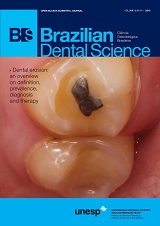Clinical Evaluation of Multiple-surface ART Restorations: Three-Year Follow-up
DOI:
https://doi.org/10.14295/bds.2013.v16i1.872Resumo
Objective: To evaluate the performance of multiple-surface restorations made with two different glass-ionomer cements (GICs) using the Atraumatic Restorative Treatment (ART) in permanent teeth. Material and methods: A total of 60 restorations were placed in schoolchildren (9-16 years of age) by two dentists using standard ART procedures. The restorations were randomly divided into two groups. Thirty cavities were filled with high-viscosity GIC (Ketac Molar-3M ESPE) and 30 cavities were filled with resin-modified GIC (Fuji VIII-GC Corp.). Two calibrated independent examiners carried out the evaluation according to ART criteria. Data were statistically analyzed using multiple logistic regression models to evaluate the variables associated with the success (GIC, operator, Class type). The 95% confidence intervals (CI) for success were based on the binomial distribution. A difference was statistically significant if p<0.05. Results:In a 3-year follow-up, 57 restorations were evaluated. In the Ketac Molar group, 3 restorations were not evaluated, 21 were considered successful and 6 unsuccessful. In the Fuji VIII group, 28 restorations were considered successful and 2 unsuccessful. The logistic regression model showed that the combination of the variables was only statistically significant in relation to survival of the ART restorations (p=0.036). There were no statistically significant differences between the groups taking each variable into account. The best performance included the combination: Fuji VIII, operator B and Class I involving two or more tooth surfaces. Conclusion: The clinical performance of the multiple-surface ART restorations of both materials was considered satisfactory with a high success rate after 3 years.
Downloads
Downloads
Arquivos adicionais
Publicado
Como Citar
Edição
Seção
Licença
TRANSFERÊNCIA DE DIREITOS AUTORAIS E DECLARAÇÃO DE RESPONSABILIDADE
Toda a propriedade de direitos autorais do artigo "____________________________________________________________________" é transferido do autor(es) para a CIÊNCIA ODONTOLÓGICA BRASILEIRA, no caso do trabalho ser publicado. O artigo não foi publicado em outro lugar e não foi submetido simultaneamente para publicação em outra revista.
Vimos por meio deste, atestar que trabalho é original e não apresenta dados manipulados, fraude ou plágio. Fizemos contribuição científica significativa para o estudo e estamos cientes dos dados apresentados e de acordo com a versão final do artigo. Assumimos total responsabilidade pelos aspectos éticos do estudo.
Este texto deve ser impresso e assinado por todos os autores. A versão digitalizada deverá ser apresentada como arquivo suplementar durante o processo de submissão.




























